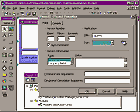
 Quote of the day - Part 2 Helen
Bradley shows you how to create a program that
displays a quote of the day on the screen
whenever you start up your computer. |
| Last month's project created
the quote file and the code for adding and
editing the quotes. This month's project creates
the form you'll see when the quotes are displayed
every day and the mechanism for linking this to
the form created last month (see Figure 1e). Begin by opening the project from last month and add a new form using Project, Add Form, Form. Add the controls and set the properties on the new form listed in the table 'Controls & properties'. The remainder of the objects can be copied from the other form. Select the form called frmManageQuotes and, holding down the Ctrl button while you do it, select the two text boxes and the label and click the Copy button. Switch to this new form and click Paste to paste these objects into the new form. Type the code from the box 'Code box #1' into the form and then save it calling it frmDisplayQuotes. As this new form is the form that you will want your user to see when the program is run each day, you'll need to change the startup form. Select Project, Project1 Properties, select the General tab, from the Startup Object list box select frmDisplayQuotes and select OK. Save the project calling it quotes.vbp. Run the program to test it. You should see the new form with a quote randomly chosen from those in the file on the screen. Selecting the Close button will exit the program. Selecting the Quotes button will load the form from last month's project allowing you to add and edit your quotes file.
|
| Final
touches To create a standalone version of the program, compile it using File, Make quotes.exe. Select the drive and directory to save your file into and select Options and choose the icon you want to use for the program's icon from the list and click OK and OK again to compile the code into an executable file (see Figure 2e). When the executable file has been created you can add it to your system's startup routine by right-clicking on the Start button on the Taskbar and select Open. Select the Program group and then select the StartUp group and add a new shortcut using File, New, Shortcut. Select the Browse button, locate the file quotes.exe on your hard disk, select the file and click Open. Select Next and type a better name for the shortcut than the filename, for example, 'Daily Quote', and select Finish. The icon for your program should appear in the StartUp group window (see Figure 3e), and you can now close the StartUp group window. The program will now run automatically whenever Windows is started.
|
| How
it works The code added to this form's form_load event is similar to that used in the other form. It opens the file containing the quotes and calculates how many quotes there are in the file. Then the program calculates a random number in the range 1 - x where x is the number of quotes in the file and displays the quote at this position in the file in the text box on the screen. Copying the text boxes and label from one form to the other means that both forms contain these identical objects. Every time the procedure readQuote is called it is passed the number of the quote to read and the name of the form that called it -- me. The procedure displays the quote text and author name on the form containing the code that called the procedure. The form frmManageQuotes is opened as a modal form -- the number 1 in the form show statement sets this state. This ensures that all input will occur only on this form while it remains visible and loaded. Until it is either hidden or unloaded you cannot access the form underneath.
|
| Customise
it Once your project is running and tested you can consider some options for customising it, such as:
|
![]()



